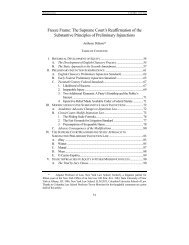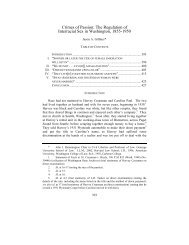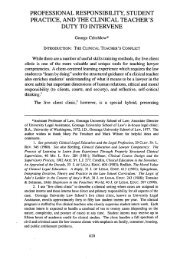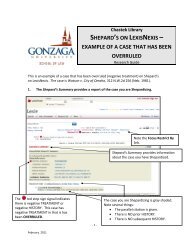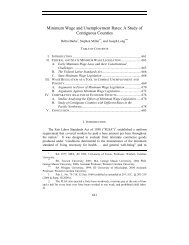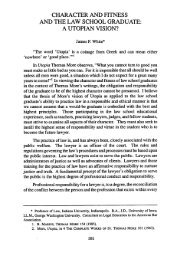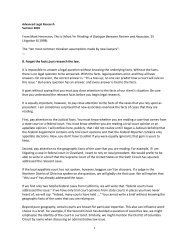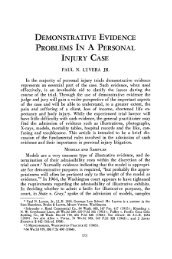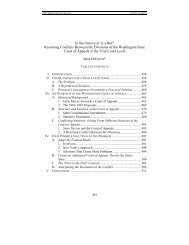I Developments in Washington's Law of Law-Making - Gonzaga ...
I Developments in Washington's Law of Law-Making - Gonzaga ...
I Developments in Washington's Law of Law-Making - Gonzaga ...
You also want an ePaper? Increase the reach of your titles
YUMPU automatically turns print PDFs into web optimized ePapers that Google loves.
2008/09]<br />
WASHINGTON'S LAW OF LAW-MAKING<br />
referendum powers, the voters exercise the same power <strong>of</strong> sovereignty that the<br />
legislature does when it enacts a statute. 54 The people may not use the <strong>in</strong>itiative<br />
power to "prevent future legislatures from exercis<strong>in</strong>g their law-mak<strong>in</strong>g powers" 55 -<br />
the voters' law-mak<strong>in</strong>g power is superior to that <strong>of</strong> the legislature only <strong>in</strong> the two-year<br />
"protection" aga<strong>in</strong>st amendment and repeal that the constitution provides to ballot<br />
measures. 56 Like the legislature, the voters act<strong>in</strong>g under their reserved powers <strong>of</strong><br />
direct democracy are bound both by the substance <strong>of</strong> the constitution and by its<br />
procedural law-mak<strong>in</strong>g requirements. 57 For example, amendment 7 did not authorize<br />
the voters to amend the constitution via the <strong>in</strong>itiative process. 58 Constitutional<br />
amendments are governed by article XXIII, which requires approval by both a<br />
legislative supermajority and the voters, rather than by article H, which establishes<br />
law-mak<strong>in</strong>g authority. 59<br />
I. THE ELEPHANT AS ROPE: BINDING THE LEGISLATURE?<br />
Part <strong>of</strong> the constitutional elephant is a rope-the constitutional procedural<br />
restrictions that shape the "method, procedure, means, and manner" <strong>of</strong> law-mak<strong>in</strong>g.<br />
But to what extent may the law-mak<strong>in</strong>g power be used to b<strong>in</strong>d itself? 60 Legal<br />
challenges to the legislative process call <strong>in</strong>to question the nature <strong>of</strong> the legislative<br />
power established <strong>in</strong> the state constitution and whether this power can be used to<br />
place limits on the law-mak<strong>in</strong>g process.<br />
54. Amalgamated Transit Union Local 578 v. State, 11 P.3d 762, 779 (Wash. 2000) (cit<strong>in</strong>g<br />
Wash. Fed'n <strong>of</strong> State Employees v. State, 901 P.2d 1028, 1034 (Wash. 1995)); Wash. State Farm<br />
Bureau Fed'n v. Gregoire, 174 P.3d 1142, 1151 (Wash. 2007). Cf Talmadge, The Initiative Process,<br />
supra note 49, at 1022 ("Perhaps the <strong>in</strong>itiative power does not, and should not, extend to budgetrelated<br />
issues.").<br />
55. Farm Bureau v Gregoire, 174 P.3d at 1151; see Kenneth P. Miller, Courts as Watchdogs<br />
<strong>of</strong> the Wash<strong>in</strong>gton State Initiative Process, 24 SEATrLE U. L. REv. 1053, 1065-66 (2001) (stat<strong>in</strong>g that<br />
<strong>in</strong>itiatives <strong>of</strong>ten attempt to constra<strong>in</strong> the representative law-mak<strong>in</strong>g process, e.g. term limits,<br />
requirements for voter approval <strong>of</strong> tax <strong>in</strong>creases).<br />
56. See <strong>Law</strong> <strong>of</strong> <strong>Law</strong>-Mak<strong>in</strong>g, supra note 8, at 456; Even, supra note 44, at 270-72; Farm<br />
Bureau v Gregoire, 174 P.3d at 1145 & n.6. The courts have construed "repeal" <strong>in</strong> a manner that<br />
favors the legislature's amendatory powers, conclud<strong>in</strong>g, for example, that replacement <strong>of</strong> one<br />
redistrict<strong>in</strong>g law with another was not "repeal." State ex rel. O'Connell v. Meyers, 319 P.2d 858,<br />
830-32 (Wash. 1957) (<strong>in</strong>terpret<strong>in</strong>g amendment 26); see Even, supra note 44, at 271-72.<br />
57. Amalgamated Transit, 11 P.3d at 779-80. See UTrER& SPTZER, supra note 21, at 50-51.<br />
58. Amalgamated Transit, 11 P.3d at 780, 794 (cit<strong>in</strong>g Gerberd<strong>in</strong>g v. Munro, 949 P.2d 1366,<br />
1377 & n. 11 (Wash. 1998)).<br />
59. Id. at 794; Gerberd<strong>in</strong>g, 949 P.3d at 1377-78.<br />
60. See WASH. REv. CODE § 41.80.010(3) (2004) (purport<strong>in</strong>g to limit the legislature's ability<br />
to consider budget legislation fund<strong>in</strong>g collective barga<strong>in</strong><strong>in</strong>g agreements); Christopher D. Abbott,<br />
Comment, Steal<strong>in</strong>g the Public Purse: Why Wash<strong>in</strong>gton's Collective Barga<strong>in</strong><strong>in</strong>g <strong>Law</strong> for State<br />
Employees Violates the State Constitution, 81 WASH. L. REV. 159, 173-78 (2006).



